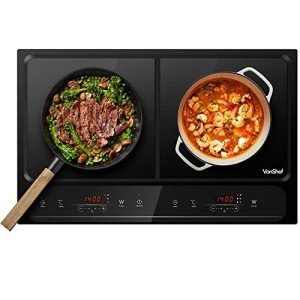Induction Hob Specifications: A Comprehensive Guide
Induction hobs have gained substantial appeal in modern cooking areas, integrating sophisticated innovation with energy effectiveness and responsiveness. For those considering the switch to induction cooking or simply seeking to update their devices, comprehending induction hob specifications is important. This guide outlines the key features, benefits, and specifications necessary for selecting the right induction hob.
Comprehending Induction Cooking
Induction hobs make use of electromagnetic fields to create heat directly within ferrous (magnetic) pots and pans. Unlike standard gas or electrical stoves, the heat is produced just in the cookware, which makes induction cooking not only faster however likewise more energy-efficient. To totally appreciate the specifications of induction hobs, it is practical to understand some basic terms and ideas.
Key Features of Induction Hobs
- Power Levels: Induction hobs typically use several power levels, allowing cooks to change the heat quickly and precisely. Higher power settings permit rapid boiling, while lower settings are perfect for simmering delicate sauces.
Size and Configuration: Induction hobs are offered in different sizes and setups. Typical alternatives include:
- Single zone: One cooking location for small spaces.
- Double zone: Two cooking locations, which might be of various sizes.
- Multizone: Larger hobs with several cooking zones that can typically be combined to accommodate bigger pots.
- Controls: Most induction hobs feature touch-sensitive controls, enabling users to adjust settings quickly and easily. Some models offer digital interfaces with timers and predetermined cooking programs.
Security Features: Induction hobs usually include safety features such as:
- Auto shut-off: Turns off the heat after a defined time of inactivity.
- Kid lock: Prevents accidental activation by children.
- Overheating security: Automatically decreases power to avoid cookware from overheating.
- Effectiveness and Speed: Induction cooking is renowned for its performance, as almost 90% of energy produced is absorbed by the pots and pans, versus only about 50-70% for gas and standard electrical cooking.
Table of Induction Hob Specifications
| Specification | Description |
|---|---|
| Power Levels | Generally between 1-9, with booster modes |
| Cooking Zones | Varying from 1 to 6 or more |
| Control Type | Touch controls, knobs, or a mixture |
| Products | Ceramic glass surface area, stainless steel |
| Dimensions | Generally 30-90 cm in width |
| Voltage | Many run at 230-240V |
| Wattage | 1400-3700W depending on the design |
| Weight | 10-30 kg depending on size and features |
Kinds Of Induction Hobs
Induction hobs are designed to satisfy the diverse needs of customers and can be categorized based on their features:
- Portable Induction Hobs: These single-zone or double-zone hobs are light-weight and ideal for small cooking areas or outside cooking.
- Integrated Induction Hobs: Installed straight into kitchen area counter tops, these hobs provide a sleek look and come in numerous sizes.
- Freestanding Induction Ranges: A complete cooking appliance that integrates an induction hob with an oven, offering a flexible service for major cooks.
- Smart Induction Hobs: Equipped with Bluetooth or Wi-Fi capabilities, these hobs can be controlled remotely, and some even consist of dish tips.
Benefits of Choosing Induction Hobs
Purchasing an induction hob can offer various advantages for any cooking area:
- Rapid Heating: Induction hobs can boil water faster than standard methods, conserving valuable cooking time.
- Energy Efficiency: By decreasing wasted heat, induction cooking is more eco-friendly and economical in the long term.
- Precise Cooking: Instant changes to temperature level make it much easier to accomplish best outcomes while cooking.
- Ease of Cleaning: Since the surface area doesn't get as hot as traditional hobs, spilled food is less likely to burn onto the surface area, making cleansing easier.
FAQs about Induction Hobs
1. Can I utilize any pots and pans on an induction hob?
No, only ferrous (magnetic) cookware appropriates for induction cooking. This consists of stainless steel and cast iron. Aluminum or glass pots and pans is not compatible unless they have a magnetic base.
2. Do induction hobs take in more electricity than other kinds of hobs?
No, induction hobs are designed to be more energy-efficient. They transform almost all their energy to heat, lowering electrical power usage substantially compared to gas or electric hobs.
3. Are induction hobs safe for kids?
Yes, induction hobs are normally safer than traditional cooking techniques. Features such as child locks, auto shut-off, and overheating protection boost security, decreasing dangers related to cooking.
4. Do induction hobs need unique installation?
While induction hobs usually require a power source of 230-240V, installation does not demand any unique adjustments besides standard electrical setup and clearance to ensure security and functionality.
5. How do I clean up an induction hob?
Cleaning up an induction hob is simple. Use Best Induction Hobs or a specialized ceramic cooktop cleaner to clean the surface carefully. Prevent utilizing abrasive materials, as they can scratch the surface.
Induction hobs represent a substantial improvement in cooking innovation, mixing efficiency with convenience. Understanding their specifications, consisting of power levels, safety features, and compatibility with cookware, enables consumers to make educated decisions. By choosing the best induction hob that fits their requirements, cooks will not just improve their kitchen experience but also unlock a world of cooking possibilities. Whether one go with a portable option, an integrated design, or a clever induction hob, one can expect trusted efficiency, security, and modern performance customized to today's cooking needs.

